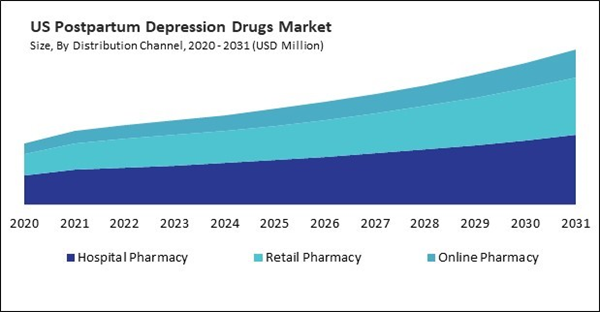The US market dominated the North America Postpartum Depression Drugs Market by Country in 2023, and would continue to be a dominant market till 2031; thereby, achieving a market value of $446.7 million by 2031. The Canada market is experiencing a CAGR of 10.9% during (2024 - 2031). Additionally, The Mexico market would exhibit a CAGR of 10.3% during (2024 - 2031).
Postpartum depression (PPD) treatment involves a multifaceted approach aimed at alleviating symptoms, improving maternal mental health, and supporting overall well-being during the postpartum period. Treatment strategies for PPD typically include a combination of pharmacological interventions, psychotherapeutic support, lifestyle modifications, and social support networks.
Postpartum depression drugs, also known as antidepressants, are medications prescribed to manage and alleviate symptoms of postpartum depression (PPD) experienced by women following childbirth. These medications are pivotal in correcting biochemical imbalances in the brain that contribute to mood disruptions. The primary application of postpartum depression drugs is to treat the symptoms of depression experienced by mothers during the postpartum period.
The Mexican government, through agencies like CONACYT (Consejo Nacional de Ciencia y Tecnología), provides funding and support for medical research, including studies aimed at developing new pharmaceutical treatments for PPD. This support accelerates the pace of innovation and ensures that new treatments are accessible to the Mexican population. Pharmaceutical companies in Mexico collaborate closely with healthcare providers and mental health professionals to understand the unique challenges and needs of Mexican women facing PPD. This collaboration facilitates the development of treatments that are effective in the local context and ensures proper implementation and monitoring. Therefore, rising medical research & innovation and increasing budget on mental health of women in the region is driving the growth of the market.
Based on Treatment, the market is segmented into Pharmacotherapy, Hormonal Therapy, and Others. Based on Route of Administration, the market is segmented into Oral, Parenteral, and Others. Based on Distribution Channel, the market is segmented into Hospital Pharmacy, Retail Pharmacy, and Online Pharmacy. Based on Type, the market is segmented into Postpartum Anxiety, Postpartum Blues, Postpartum Obsessive-Compulsive Disorder (OCD), Postpartum Panic Disorder, Postpartum Post-Traumatic Stress Disorder (PTSD), and Postpartum Psychosis. Based on countries, the market is segmented into U.S., Mexico, Canada, and Rest of North America.
List of Key Companies Profiled
- Pfizer, Inc.
- Eli Lilly And Company
- Novartis AG
- GlaxoSmithKline PLC (GSK)
- Merck & Co., Inc.
- Biogen, Inc.
- Teva Pharmaceutical Industries Ltd.
- Bausch Health Companies, Inc.(DermTech, Inc.)
- Cipla Limited
- Sage Therapeutics, Inc.
Market Report Segmentation
By Treatment- Pharmacotherapy
- Hormonal Therapy
- Others
- Oral
- Parenteral
- Others
- Hospital Pharmacy
- Retail Pharmacy
- Online Pharmacy
- Postpartum Anxiety
- Postpartum Blues
- Postpartum Obsessive-Compulsive Disorder (OCD)
- Postpartum Panic Disorder
- Postpartum Post-Traumatic Stress Disorder (PTSD)
- Postpartum Psychosis
- US
- Canada
- Mexico
- Rest of North America
Table of Contents
Companies Mentioned
- Pfizer, Inc.
- Eli Lilly And Company
- Novartis AG
- GlaxoSmithKline PLC (GSK)
- Merck & Co., Inc.
- Biogen, Inc.
- Teva Pharmaceutical Industries Ltd.
- Bausch Health Companies, Inc.(DermTech, Inc.)
- Cipla Limited
- Sage Therapeutics, Inc.
Methodology

LOADING...









